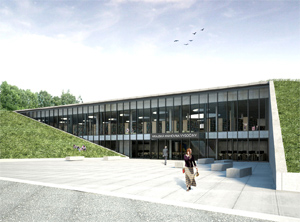
Based on competitions, very few public cultural buildings are created
 |
Just like Kaplický's blob, the regional libraries in Ostrava and Havlíčkův Brod, the gallery in Plzeň, and the Central European Forum in Olomouc have either been canceled or are at least postponed indefinitely. Five years will pass from the announcement of the NK competition results on March 2.
The Czech Chamber of Architects (ČKA) has long advocated for holding architectural competitions, especially for public buildings. Although the way the winner of the NK competition was chosen was criticized by the chamber, experts agree that it is generally the only way to achieve the best result while also saving money.
In recent years, several architectural competitions have been held for similar institutions as the NK, but only two libraries have been built so far. In 2009, eight years after the competition, the National Technical Library designed by the Projektil studio was opened, which was created relatively quietly beside the heightened emotions surrounding Kaplický's blob project. A year earlier, the Study and Research Library in Hradec Králové was opened. Its creator is also the Projektil studio, winner of the competition in 2002. The X-shaped building took four years to construct and cost 405 million crowns.
 |
A fate comparable to the NK project is the proposal for the Moravian-Silesian Scientific Library for Ostrava. In 2004, the proposal by architects Ladislav Kuba and Tomáš Pilář won the competition, but the region was reportedly unhappy with the high price and wanted to commission the construction in a different way; later it completely canceled the project. It even decided to send 600 million crowns from European funds elsewhere - to healthcare and education.
There was also a competition for the identity of the Central European Forum headquarters in Olomouc, an organization focused on modern Central European art. It was officially established in June 2008 in the presence of the Visegrad Four ministers; however, the Czech Ministry of Culture excluded the half-billion project from applications for European subsidies.
An architectural competition was also held for the new building of the West Bohemian Gallery, announced by the Plzeň Region. In 2009, Kuba and Pilář won, but construction did not start, and the region now says that it will begin construction costing approximately 700 million crowns if it manages to secure European subsidies in the next funding period, that is, after 2014.
According to the ČKA, relatively few architectural competitions are announced in the Czech Republic compared to neighboring countries. While in Austria and Germany 100 to 300 architectural competitions are announced annually, in the Czech Republic, there are only ten to 20. According to the ČKA, about 60 to 100 projects per year should have a competition in the Czech Republic. Most project work is commissioned through selection procedures with a narrow circle of participants; sometimes the commissioner does not even do that.
The most glaring recent examples, according to the ČKA, are the Justice Palace in Brno or the campus of Jan Evangelista Purkyně University in Ústí nad Labem. The overpricing of the Brno Justice Palace even led the financial office to impose a two-billion fine on the regional court as the commissioner. In 2005, it was estimated that the construction would cost 805 million, but the total costs reached 1.938 billion. The initial underestimation of construction costs happens often. Investors do this to get things moving, to perhaps outpace other public contracts within the state budget. A publicly initiated construction must then be completed even at the cost of overspending.
The English translation is powered by AI tool. Switch to Czech to view the original text source.
0 comments
add comment
Related articles
3
19.01.2011 | Funding is missing for the new building of the West Bohemian Gallery in Plzeň.
2
16.06.2009 | In Ostrava, a petition was created for the construction of the original scientific library
8
15.06.2009 | Technical Library leaves Klementinum after decades
6
13.01.2009 | The Regional Court in Brno was fined due to the judicial palace











